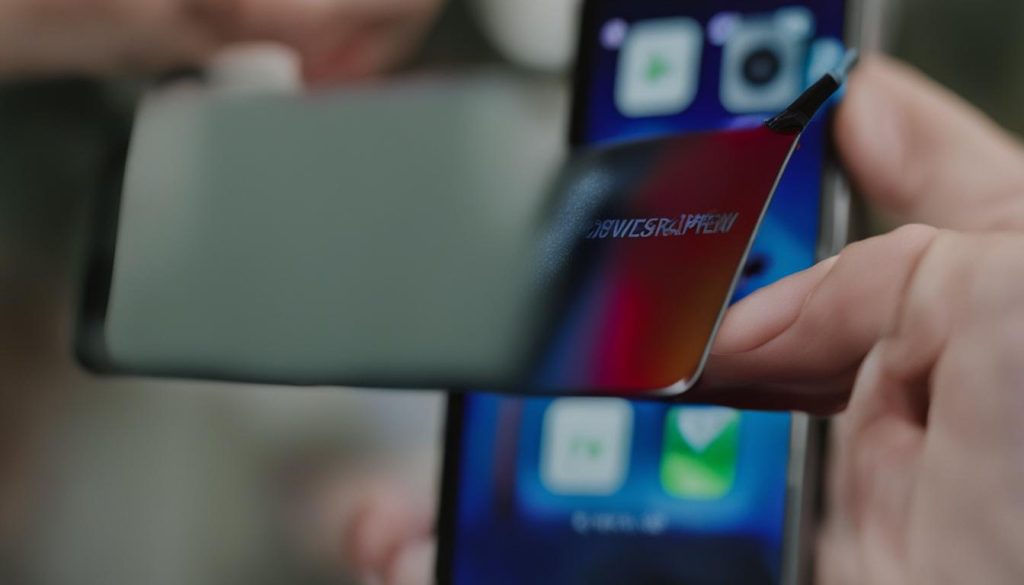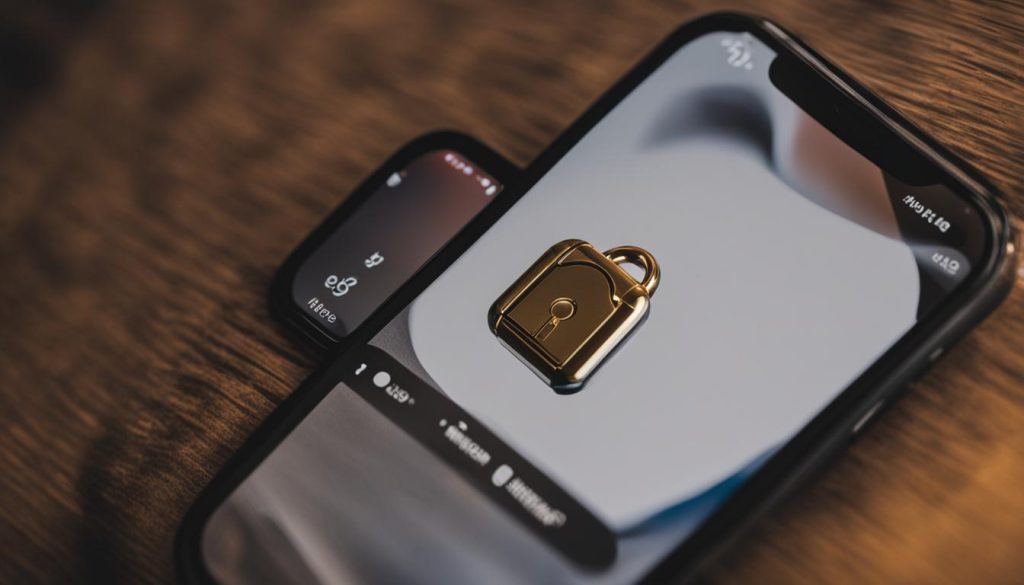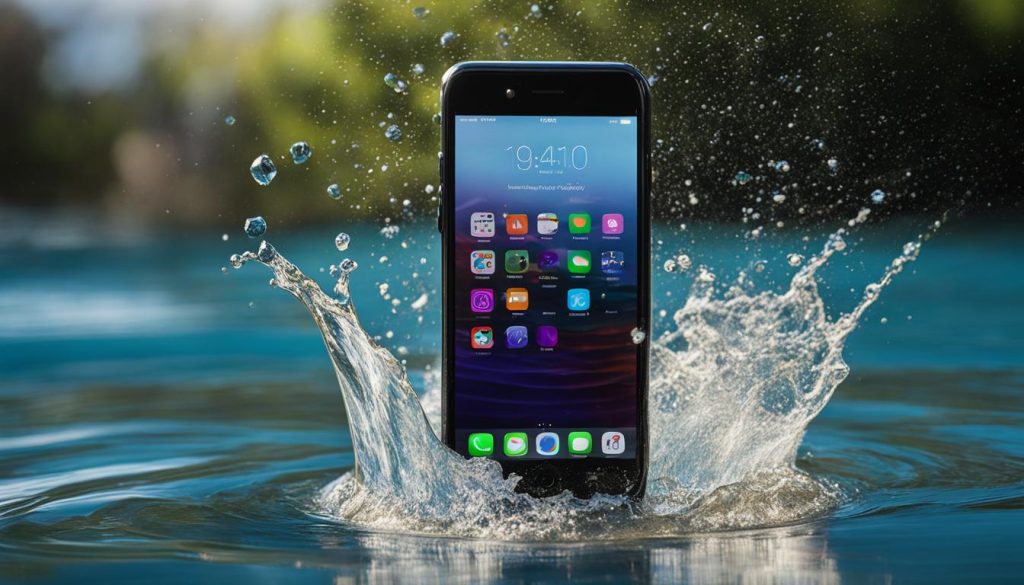As technology advances, ensuring the security of our online communications has become increasingly crucial. With the rise of messaging apps, we need to ask ourselves: Can the Signal app be hacked? Signal, known for its robust security and commitment to privacy, has gained popularity as a secure messaging platform. However, no app is impervious to hacking attempts. In this section, I will delve into the potential vulnerabilities and security risks associated with the Signal app.
Key Takeaways:
- The Signal app, while highly secure, is not completely immune to hacking attempts.
- Understanding the basics of Signal’s security measures is crucial for users.
- Potential risks associated with using the Signal app include malware, phishing attacks, social engineering, and phone number hijacking.
- Signal has implemented various measures to address security risks, including a bug bounty program and regular security updates.
- Users can take additional steps to protect their Signal accounts, such as using strong passwords and enabling two-factor authentication.
The Basics of Signal Security
Signal is renowned for its strong emphasis on security and privacy. In this section, we will delve into the fundamental aspects of Signal’s security measures, exploring its encryption strength and other security protocols.
At the core of Signal’s security is its implementation of end-to-end encryption. This means that the content of all messages, calls, and shared media is encrypted in such a way that only the sender and intended recipient can access it. This robust encryption ensures that even if intercepted, the data remains unreadable to external parties.
In addition to end-to-end encryption, Signal incorporates other security features to bolster user protection. One such feature is forward secrecy, which ensures that even if an encryption key is compromised, past communications cannot be decrypted. Signal also offers two-factor authentication, providing an extra layer of security by requiring users to verify their identity through a secondary authentication method.
By employing these encryption and security measures, Signal strives to create a highly secure messaging environment, where users can communicate with confidence, knowing that their conversations and data remain private and protected.
Signal App Encryption Strength
| Encryption Method | Strength |
|---|---|
| End-to-End Encryption | Strong |
| Forward Secrecy | High |
| Two-Factor Authentication | Robust |
The Risks of Signal Hacking
Signal may provide strong security measures, but it is not completely immune to hacking attempts. Users need to be aware of the potential risks and take proactive steps to shield their Signal app from hacking attempts. Some common methods used by hackers to compromise Signal accounts include malware or spyware, phishing attacks, social engineering, and phone number hijacking.
Malware or spyware: Hackers may attempt to install malicious software on a user’s device, compromising the security of their Signal app. This can allow them to gain unauthorized access to messages and other sensitive information.
Phishing attacks: Phishing emails or messages mimic legitimate sources and trick users into revealing their login credentials or other sensitive data. By impersonating Signal, hackers can deceive users and gain unauthorized access to their accounts.
Social engineering: In social engineering attacks, hackers manipulate individuals into divulging sensitive information or performing actions that compromise their accounts. They may impersonate friends or colleagues, creating a false sense of trust and convincing users to share personal information or click on malicious links.
Preventing Signal App Hacking
To protect your Signal account from hacking attempts, it is essential to implement the following security practices:
- Keep your device secure: Ensure that your device has the latest security updates and use strong, unique passwords for your device and Signal app.
- Enable two-factor authentication: By enabling two-factor authentication, you add an extra layer of security to your Signal account. This requires providing a second form of verification, such as a fingerprint or PIN, in addition to your password.
- Be cautious with messages and links: Avoid clicking on suspicious links or opening attachments from unknown sources. Be wary of any requests for personal information or login credentials.
- Regularly verify contacts’ identities: Before sharing sensitive information or engaging in confidential conversations, verify that you are communicating with the intended recipient. Signal offers security numbers for each contact, which can be used to confirm their authenticity.
By staying vigilant and implementing these preventive measures, you can significantly reduce the risk of Signal app hacking and ensure the privacy and security of your personal communication.


Signal’s Response to Security Risks
Signal takes the security of its users seriously and has implemented several measures to address potential security risks. One of the key initiatives Signal has in place is a bug bounty program. This program encourages users, as well as security researchers, to identify and report any security vulnerabilities they discover in the app. By offering rewards for these reports, Signal incentivizes the community to actively participate in improving the app’s security.
In addition to the bug bounty program, Signal regularly updates its security protocols to stay ahead of emerging threats. These updates not only address any identified vulnerabilities but also enhance the overall security of the app. By regularly releasing security updates, Signal ensures that its users have access to the latest protection against potential hacking attempts.
Another factor that contributes to Signal’s robust security is the open-source nature of the app. Being open-source allows the broader security community to review the app’s code and identify any potential weaknesses or vulnerabilities. This collaborative effort ensures that any security issues can be quickly identified and resolved, further strengthening the overall security of the app.
Signal’s Commitment to User Security
Signal’s bug bounty program, regular security updates, and open-source approach demonstrate the company’s commitment to user security. By actively engaging with the community and continuously improving the app’s security measures, Signal strives to create a safe and secure messaging environment for its users.
Table: Signal’s Security Features
| Security Feature | Description |
|---|---|
| End-to-End Encryption | Protects messages, calls, and shared media, ensuring only the intended recipients can access the content. |
| Forward Secrecy | Generates unique encryption keys for each message, preventing past communications from being compromised even if one key is compromised. |
| Two-Factor Authentication | Adds an extra layer of security by requiring users to verify their identity with a second factor, such as a fingerprint or PIN. |
| Bug Bounty Program | Rewards users and security researchers for identifying and reporting security vulnerabilities. |
| Regular Security Updates | Ensures that the app’s security protocols are up to date and addresses any newly discovered vulnerabilities. |
| Open-Source Code | Allows security experts to review and contribute to the app’s security, ensuring a quick response to any potential threats. |


By combining these security features and actively engaging with the security community, Signal remains at the forefront of secure messaging apps. Users can feel confident in the app’s ability to protect their communications and personal information.
Tips for Keeping Your Signal Account Secure
As users of the Signal app, it is important to take proactive steps to ensure the security of our accounts. While Signal is already equipped with robust security measures, adding an extra layer of protection can offer peace of mind. Here are some tips to help you keep your Signal app secure:
1. Use a strong password: Create a unique and complex password for your Signal account. Avoid using common passwords or easily guessable phrases. A strong password typically includes a combination of uppercase and lowercase letters, numbers, and special characters.
2. Keep your device secure: Regularly update your device’s operating system and Signal app to the latest versions. Enable device lock features such as PIN or biometric authentication to prevent unauthorized access to your device and Signal app.
3. Enable two-factor authentication: Add an extra layer of security to your Signal account by enabling two-factor authentication. This feature requires you to verify your identity using a secondary method, such as a one-time password (OTP) sent to your registered phone number.
4. Verify contacts’ identities: Before engaging in sensitive conversations, make sure to verify the identity of the contacts you are communicating with. This can be done by comparing security numbers or using other secure channels to confirm their identities.
By following these tips, you can significantly enhance the security of your Signal account and minimize the risk of hacking attempts. Remember, staying vigilant and taking proactive measures is crucial in safeguarding your personal communication.
| Tips for Keeping Your Signal Account Secure |
|---|
| Use a strong password |
| Keep your device secure |
| Enable two-factor authentication |
| Verify contacts’ identities |
Understanding the Encryption Behind Messaging Apps That Safeguard Private Texts
Messaging app encryption plays a pivotal role in ensuring the security of private texts. End-to-end encryption, as used by Signal, is a key component of this process. It works by encrypting the communication at the sender’s device and decrypting it only at the recipient’s device, ensuring that the content remains secure and inaccessible to any unauthorized parties.
Signal’s use of end-to-end encryption means that even if someone intercepts the messages or gains access to the servers, they would not be able to decipher the content. This level of security is bolstered by additional measures such as forward secrecy, which generates unique encryption keys for each message, making it virtually impossible to decrypt previous messages even if one key is compromised.
Signal’s dedication to securing private texts is further emphasized by its commitment to open-source development. By allowing security experts to review and audit the app’s code, any potential vulnerabilities can be quickly identified and addressed. This transparency is a crucial aspect of ensuring the ongoing security of Signal and maintaining user trust.
In summary, messaging app encryption, particularly end-to-end encryption, is essential for safeguarding private texts. Signal’s implementation of this encryption method, alongside additional security measures such as forward secrecy, highlights its commitment to user privacy and security. Furthermore, the open-source nature of Signal allows for continuous improvement and the prompt identification and resolution of any potential vulnerabilities. With Signal, users can have confidence in the security of their private communications.
Signal’s Security Measures and Encryption Methods
When it comes to protecting user information, Signal employs a range of effective security measures. In Signal chats, security numbers are used to verify the authenticity of conversations and ensure the integrity of the communication. These security numbers, also known as safety numbers, are unique to each chat and can be compared with the person you are communicating with to confirm that your chat has not been compromised.
Signal also prioritizes transparency and accountability by making its code open-source. This means that security experts can review the code and identify any potential vulnerabilities, ensuring a quick response to any security issues that may arise. The open-source nature of Signal’s code allows for peer review, which contributes to its overall security and strengthens user confidence in the app.
In addition to these measures, Signal employs advanced encryption methods to protect user data. The app uses its proprietary protocol called Signal Protocol, which is renowned for its security and has been independently audited. Signal also implements Perfect Forward Secrecy (PFS), a feature that ensures even if an attacker gains access to encrypted communication, they cannot decrypt past messages. This provides an extra layer of security and prevents unauthorized access to sensitive information.
In summary, Signal’s commitment to user security is evident in its implementation of security numbers, open-source code, and strong encryption methods. By incorporating these measures, Signal ensures the privacy and security of user conversations. Users can trust that their communication remains confidential, protecting sensitive information from potential hacking attempts.
Personal Data and Privacy in Signal
When it comes to personal data and privacy, Signal takes user security seriously. The app minimizes the collection of personal data, ensuring that users have control over their information. Signal collects certain data, such as phone numbers and contact lists, but it does not collect message contents or information about contacts and groups. This approach ensures that user communications remain private and protected.
Signal stores personal data securely, employing strong encryption methods to safeguard user information. With end-to-end encryption, only the sender and recipient can access the content of the messages, calls, and shared media. This means that even if someone were to intercept the data, they would not be able to decipher or read it.
Signal’s commitment to privacy is further reinforced by its open-source nature. The app’s code is available for review by security experts, allowing for transparency and accountability. This allows any potential vulnerabilities to be identified and promptly addressed, ensuring that user data is not compromised.
| Personal Data Collected by Signal | Personal Data Not Collected by Signal |
|---|---|
| Phone numbers | Message contents |
| Contact lists | Information about contacts and groups |
Signal’s commitment to privacy and the minimal data collection practices make it a trusted choice for those concerned about their personal information. By prioritizing user privacy and employing robust encryption methods, Signal ensures that user data is protected and secure.
Disadvantages of Using Signal App
As much as Signal is praised for its security and privacy features, there are some limitations and drawbacks that users should be aware of. While these may not outweigh the app’s advantages, it is important to consider them before making it your primary messaging platform.
One of the main drawbacks of Signal is its small user base compared to popular messaging apps like WhatsApp and Telegram. This can make it challenging to find and connect with all of your contacts, especially if they are not already using Signal. While the app continues to gain popularity, it may take time for it to become more widely adopted.
Another limitation of Signal is the inability to back up your message history. Unlike some other messaging apps, Signal does not offer an automatic backup feature, which means that if you switch devices or uninstall the app, your message history will be lost. This can be frustrating for users who value being able to access and restore their conversations.
Signal’s lack of simultaneous use across multiple devices is also worth noting. Currently, the app only supports one active device per account. This means that if you log into Signal on a new device, it will deactivate the app on your previous device. While this is done to enhance security, it can be inconvenient for users who frequently switch between devices.
Lastly, Signal may not be the ideal messaging platform for businesses or organizations. While it offers strong security features, it lacks some of the collaboration and integration capabilities found in other messaging apps specifically designed for business use. If you rely heavily on features like file sharing, calendar integration, or team collaboration, you may find Signal to be limited in meeting your needs.
Summary:
- Signal’s small user base can make it difficult to connect with all your contacts.
- The app does not offer automatic message history backup, resulting in potential loss of conversations.
- Signal only supports one active device per account, limiting simultaneous use across multiple devices.
- For businesses, Signal may lack some collaboration and integration capabilities found in other messaging apps.
It is important to weigh these limitations against the app’s security and privacy features to determine if Signal is the right messaging app for you.
Signal vs. Main Competitors
When it comes to secure messaging apps, Signal faces tough competition from other popular platforms like WhatsApp, Telegram, and TrueConf. Each of these apps has its own strengths and weaknesses, making it important to assess their security features, privacy practices, available features, and user base.
WhatsApp, owned by Facebook, boasts a massive user base, making it one of the most widely used messaging apps worldwide. However, it has faced criticism for its data privacy practices and encryption protocols. While WhatsApp uses end-to-end encryption, the fact that it is owned by a company known for data collection raises concerns for some users.
Telegram, on the other hand, is known for its advanced security features and focus on privacy. It also offers features like secret chats that have additional encryption layers. However, Telegram is a cloud-based messaging app, which means that it stores messages and other data on its servers. This centralized approach raises questions about data privacy and security.
Signal’s dedication to user privacy and its strong encryption protocols set it apart from its competitors. By using open-source code and implementing end-to-end encryption, Signal ensures that only the intended recipients can access the content of a message or call.
TrueConf, while not as widely known as the other apps mentioned, is gaining popularity as a secure messaging app. TrueConf offers end-to-end encryption and also allows users to conduct encrypted video conferences. However, it may not have the same level of recognition or user base as Signal, WhatsApp, or Telegram.
In conclusion, Signal stands out as one of the most secure messaging apps available, prioritizing user privacy and employing strong encryption protocols. While each competitor has its own strengths and weaknesses, Signal’s commitment to user security, open-source code, and end-to-end encryption make it a top choice for individuals seeking a secure messaging platform.
Conclusion
In conclusion, Signal stands as one of the most secure messaging apps available in the market today. With its robust encryption and comprehensive security measures, Signal ensures that users can communicate with confidence and protect their privacy.
While no app is completely hack-proof, Signal takes significant steps to safeguard user information. The implementation of end-to-end encryption, forward secrecy, and two-factor authentication contributes to the app’s strong security framework.
By following the recommended tips for account security, Signal users can further enhance their protection against potential hacking attempts. From using strong passwords to enabling two-factor authentication and verifying contacts’ identities, these measures empower users to maintain a secure messaging environment.
It is crucial to understand and be aware of the risks associated with using any app, including Signal. However, with Signal’s commitment to regular security updates and open-source code, security vulnerabilities are swiftly identified and addressed by a proactive development team.
FAQ
Can the Signal app be hacked?
While Signal has strong security measures in place, no app is completely immune to hacking attempts. Users should be aware of potential risks and take steps to protect their accounts.
What security measures does Signal employ?
Signal utilizes end-to-end encryption, forward secrecy, and two-factor authentication to enhance app security and protect user data.
How can Signal be hacked?
Some common hacking methods include malware or spyware, phishing attacks, social engineering, and phone number hijacking. It is important to stay vigilant and take precautions to prevent hacking attempts.
How does Signal respond to security risks?
Signal has a bug bounty program that rewards users for reporting security vulnerabilities. The app also regularly updates its security protocols to address new threats.
What can users do to keep their Signal accounts secure?
Users can take steps such as using strong passwords, securing their devices, enabling two-factor authentication, and verifying contacts’ identities to enhance the security of their Signal accounts.
How does encryption work in messaging apps?
Encryption ensures that only the sender and recipient can access the content of a communication. End-to-end encryption, like that used by Signal, is particularly effective in safeguarding private texts.
What security features does Signal have?
Signal uses security numbers to verify the authenticity of chats and employs open-source code to identify and address vulnerabilities. It also utilizes encryption methods such as its proprietary protocol and Perfect Forward Secrecy.
What personal data does Signal collect?
Signal collects minimal personal data, such as phone numbers and contact lists, which are stored and used securely. However, it does not collect message contents or information about contacts and groups.
What are the drawbacks of using Signal?
Some limitations include a small user base, the inability to back up message history, the lack of simultaneous use across multiple devices, and limitations for business use.
How does Signal compare to its competitors?
Signal’s strengths and weaknesses can be evaluated in comparison to rival messaging apps in terms of security, privacy, features, and user base.






